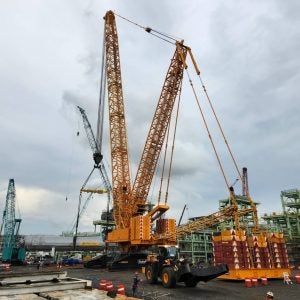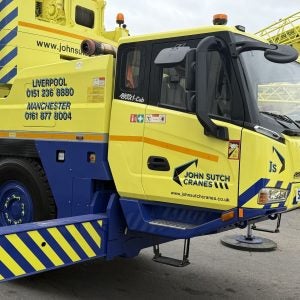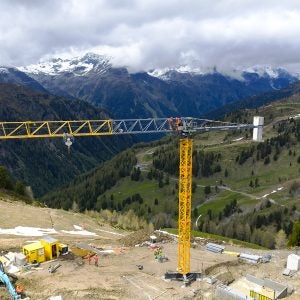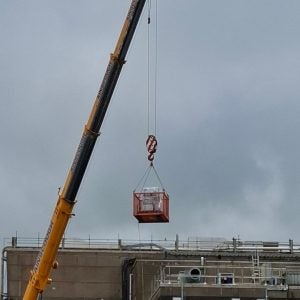Kier Plant had hired a Liebherr 78EC tower crane with 45m jib and 37m mast to the apartment developer, Bellway Homes. The tower was installed on fixing angles through a lift shaft on the seven-storey, timber-framed building. The development was nearing completion with some roof sections already in place. Kier was expecting to receive an instruction to dismantle the crane and remove it from site around the end of April.
The development was adjacent to completed and occupied apartments to two sides and bounded by a single track railway to the rear. In front of the site, Dunne Group was using two of their own luffing jib tower cranes, on the early stages of another development.
The fire broke out on the afternoon of 5 April, a Saturday. The fire service was on site within a few minutes but had difficulty fighting the blaze due to the intensity and high speed at which the fire spread and engulfed the entire building. There were concerns that the burning building, the scaffolding and the tower crane could collapse due to the fire damage. As a precaution, residents of the adjoining flats were evacuated. The area was then secured to prevent re-entry.
Kier Plant’s tower crane department were informed of the situation by Bellway Homes. The manager of the nearby Kier Plant Stepps depot, John Schoolar, was contacted and asked to attend the site with a crane operator and one of the sub-contract crane engineers from Glasgow to advise Bellway on the stability of the crane.
Discussions with Liebherr GB took place Saturday evening using their emergency contact numbers, and advice from the factory was requested on the effects of excess heat on the tower structure. UK service manager Ed Hudson offered his services and those of a specialist engineer from Liebherr Germany, Christian Jung.
Kier Plant operations director Pat Glynn arrived on site early Sunday morning.
The tower crane mast was out of plumb but the upper works were seen to be free slewing in the wind. The fabric of the site had burnt almost totally and was surrounded by scaffolding and steelwork which had been warped and twisted by heat.
On inspecting the crane foundations, they appeared sound and untouched by the fire but when looking up the mast a distortion could be seen at around the half-way point of the 37m tower.
A viewing of the tower from above was arranged using the fire service’s Snorkel lift. This revealed that there was serious damage and apparent weakening of the tower, causing it to stand out of plumb. It was thought that the possibility of collapse was unlikely, but the weakened tower would cause complications with the dismantling as the tower stresses are at their highest during the dismantling process. This meant that measures to reduce the loading had to be taken.
A number of briefings were held during the course of the day. It was decided that dismantling the tower crane was the most urgent and critical task, as the rest of the burnt building could not be safely demolished until this had taken place.
Kier Plant operations manager Paul Linney was appointed to run the recovery operation and arrived in Leith on Sunday evening. On Monday morning a mobile crane with man rider arrived on site from Ainscough so that the damaged crane could be surveyed from height without entering the site.
Kier Plant discussed various options and methods to dismantle the crane and decided that it would be necessary to use three mobile cranes in order to prevent overloading of the weakened tower. Ainscough crane hire were consulted and after calculations received from Liebherr, the capacities of the cranes were established using a 25% additional safety margin.
The method involved one crane holding the counter jib, another holding the front jib and the third crane being used with a man rider to provide access for erectors so that they could work on the tower crane without climbing through the damaged tower. This crane was also used to remove the counter weights and lift light components.
A method statement and risk assessment were drawn up using CAD drawings of the site from Bellway’s architects so that the cranes could be positioned accurately on site avoiding underground services. This document was discussed and developed with an inspector from the HSE who attended site.
The mobile cranes were hired through Ainscough and finalised as a 100t Liebherr from Ainscough, 130t Grove from James Jack (which became part of Ainscough in early April) and a 200t Liebherr from Mammoet.
Paul Linney controlled the operation with a Kier Plant team, assisted by engineers from Liebherr. By mid-afternoon, the crane upper works were being placed on transport for return to the Setch depot. The engineering team had expected that some of the tower would have to abandoned at the site. The inspection had shown that it was unsafe to release the lower tower bolts, as it was unsafe to access the crane base due to the unstable block-work of the lift shaft. These lower parts were left in place, to be removed as the rest of the building was demolished,
The tower crane is now at the Setch depot and Kier plant are awaiting advice from Liebherr on an inspection and test procedure required to ensure the future integrity of the machine.
Kier Plant operations director Pat Glynn, said, “This incident has illustrated the ability of Kier Plant to respond safely and effectively to an emergency situation using our own experienced trained and competent team of management and technicians, backed up by the Chawston office and Setch depot. The efforts of all Kier Plant personnel are commended and appreciated. Thanks to all those others that made the operation a success.”






